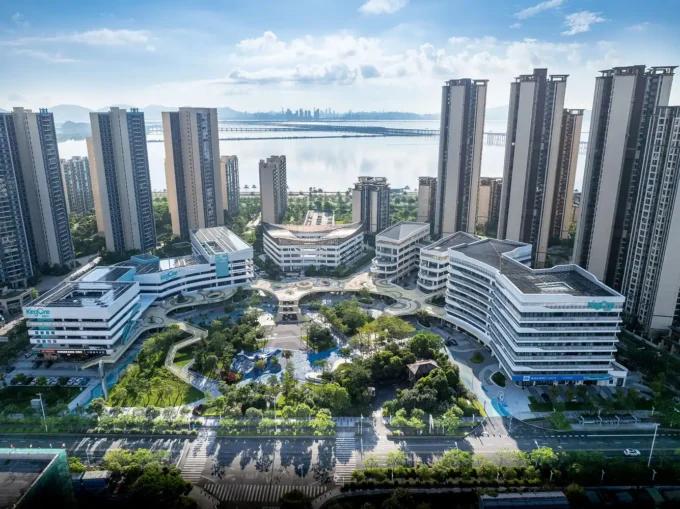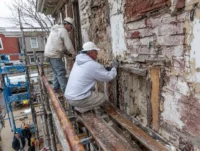The Unimed Federation headquarters in Porto Alegre represents a thoughtful intervention in the urban fabric, guided by principles of adaptive reuse, sustainable expansion, and architectural generosity. Recognizing that “the most sustainable building is the one that has already been built,” AT Arquitetura proposed a design that respects the historical and cultural significance of the original structure while introducing modern strategies to meet contemporary functional requirements. By acquiring three adjacent lots, the new complex does more than expand—it creates a public square that serves as a transitional space between the city and the building, inviting both employees and visitors to engage with the urban environment.
The design positions the new construction with a deliberate setback, establishing a pedestrian-friendly plaza while maintaining the rhythm and scale of the surrounding streetscape. This gesture demonstrates the firm’s commitment to urban generosity, balancing corporate identity with public accessibility, and creating an architectural narrative that bridges Porto Alegre’s past and future.

Architectural Design
The headquarters is a hybrid of old and new, seamlessly merging the preserved portions of the existing building with contemporary interventions. The design combines the original framework with an independent structural system, allowing the new wing to meet modern operational needs without compromising the integrity or memory of the former structure. This duality creates a building that is both respectful of history and forward-looking in its adaptability. The preserved sections of the old building, with their material texture, scale, and rhythm, dialogue with the new architectural elements, resulting in a cohesive yet layered composition that acknowledges time, memory, and urban context.
The new wing is articulated to maximize flexibility and user comfort, with an open-plan layout that accommodates a variety of work environments. Silent focus areas, collaborative work zones, modular meeting rooms, and informal social areas coexist within a continuous spatial flow. Circulation is unobstructed, promoting connectivity and transparency while allowing each area to function independently if needed. The building’s volumetric composition responds to solar orientation, with carefully designed façade elements that regulate daylight and offer visual connections to the surrounding city. In this way, interior and exterior spaces are interwoven, reinforcing the building’s human-centered scale and establishing a strong sense of place.

Façade and Materiality
A defining feature of the design is the metallic façade, composed of perforated panels and brise-soleils that modulate natural light and reduce unwanted heat gain. This high-performance envelope integrates passive strategies, such as cross-ventilation and optimized solar orientation, creating a comfortable indoor environment while minimizing energy consumption. The perforations in the metal panels introduce dynamic shadow patterns throughout the day, animating the building’s exterior and enriching the visual experience of both occupants and passersby. The material palette, which balances industrial elegance with warmth and tactility, ensures that the building conveys professional gravitas while remaining approachable and engaging.
The new construction contrasts yet complements the existing structure, using contemporary forms and materials to highlight the hybrid character of the complex. Transparent glazed elements allow light to penetrate deep into workspaces, while visual connections between floors and the surrounding urban fabric enhance a sense of openness and community. These strategies together produce an architecture that is both functional and expressive, blending modern performance with a refined aesthetic.

Sustainable Design
Sustainability is embedded at every scale of the project. By retaining and repurposing the original building, the design minimizes the environmental impact associated with demolition and new construction. Passive design strategies reduce reliance on mechanical systems: natural ventilation and solar shading enhance thermal comfort, while rooftop terraces and open courtyards provide outdoor spaces that extend the building’s interior life. The terraces also act as communal hubs, promoting well-being, social interaction, and moments of respite amidst the workplace.
Energy efficiency is further reinforced through the metallic façade system, which responds to solar exposure and optimizes daylight penetration without excessive heat gain. This combination of passive and active strategies reduces operational energy requirements and reinforces the project’s environmental ethos. Landscaping around the plaza and terraces contributes to biodiversity, mitigates urban heat island effects, and enhances the overall microclimate. In essence, sustainability is not an add-on—it is intrinsic to the design philosophy, connecting architectural form, functional performance, and environmental responsibility.

Experiential and Urban Impact
The Unimed Federation complex is conceived not just as a workplace but as a social and urban landmark. The setback plaza encourages pedestrian engagement and provides a welcoming threshold between public and private realms. Inside, the fluid arrangement of spaces encourages collaboration, creativity, and human-centered interaction, while rooftop terraces foster social cohesion and relaxation. Natural light, material warmth, and visual connections to the city create a layered sensory experience that balances professional rigor with comfort and accessibility.
By integrating historical preservation, sustainable strategies, and contemporary design thinking, AT Arquitetura has created a headquarters that is both a symbol of corporate identity and a civic asset. The building demonstrates that adaptive reuse, thoughtful materiality, and contextual responsiveness can coexist with flexibility and modern efficiency. It serves as a model for how contemporary office complexes can enrich their urban surroundings, prioritize sustainability, and offer a meaningful experience for all users.

Conclusion
The Unimed Federation headquarters stands as a testament to adaptive design, sustainability, and urban generosity. Its hybrid structure, high-performance metallic façade, and flexible interior environments make it a forward-thinking workplace, while the setback plaza and rooftop terraces strengthen connections with the city and its inhabitants. This project exemplifies how architecture can balance functional excellence, environmental responsibility, and human experience, offering a workplace that is both efficient and inspiring, modern yet respectful of its historical roots.
Photography: Manuel Sá
- adaptive reuse architecture
- Architectural materiality
- AT Arquitetura
- Contemporary workplace architecture
- Contextual responsive architecture
- Corporate headquarters design
- energy-efficient architecture
- Environmentally conscious office
- Historical preservation in architecture
- Human-centered office design
- Hybrid architecture
- Metallic façade design
- Modern office buildings
- passive design strategies
- Pedestrian-friendly plaza design
- Porto Alegre architecture
- Rooftop terraces and courtyards
- Sustainable office design
- Unimed Federation Headquarters
- Urban integration architecture






















































Leave a comment